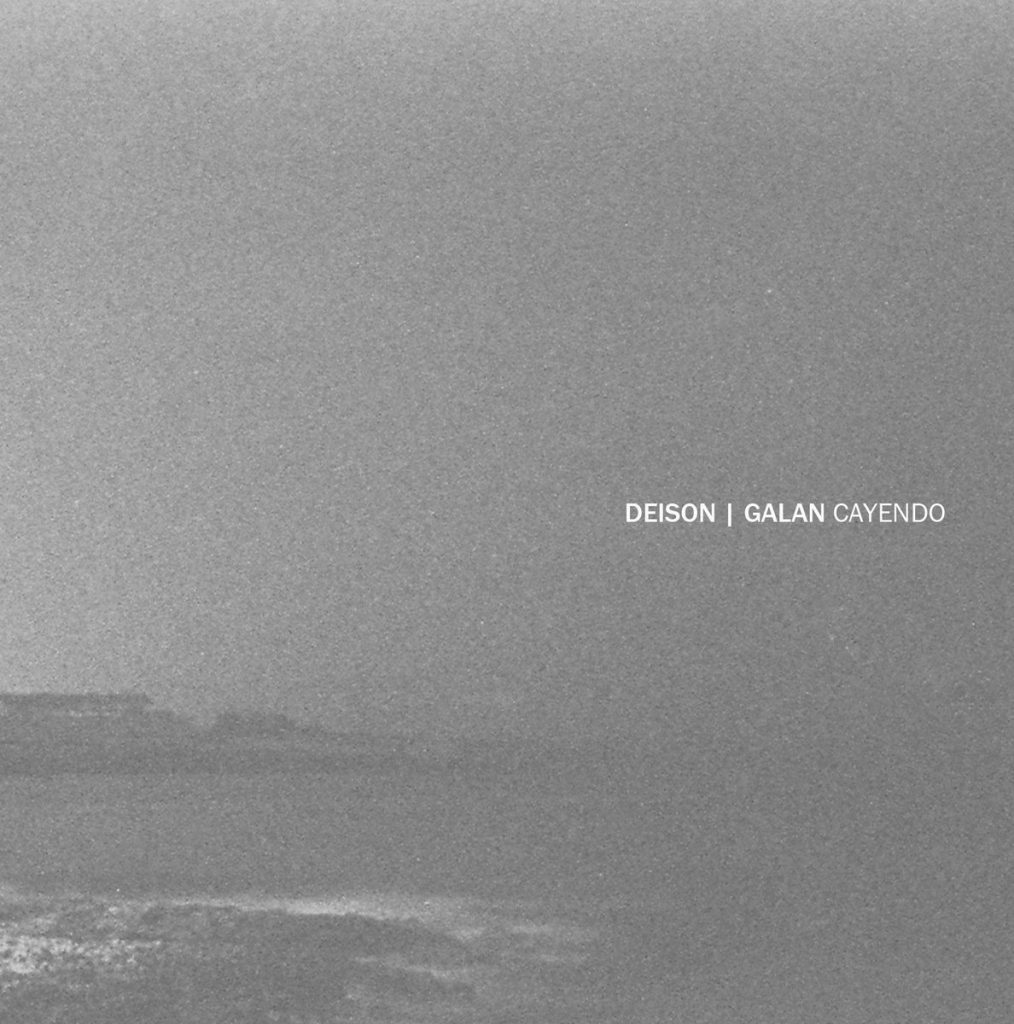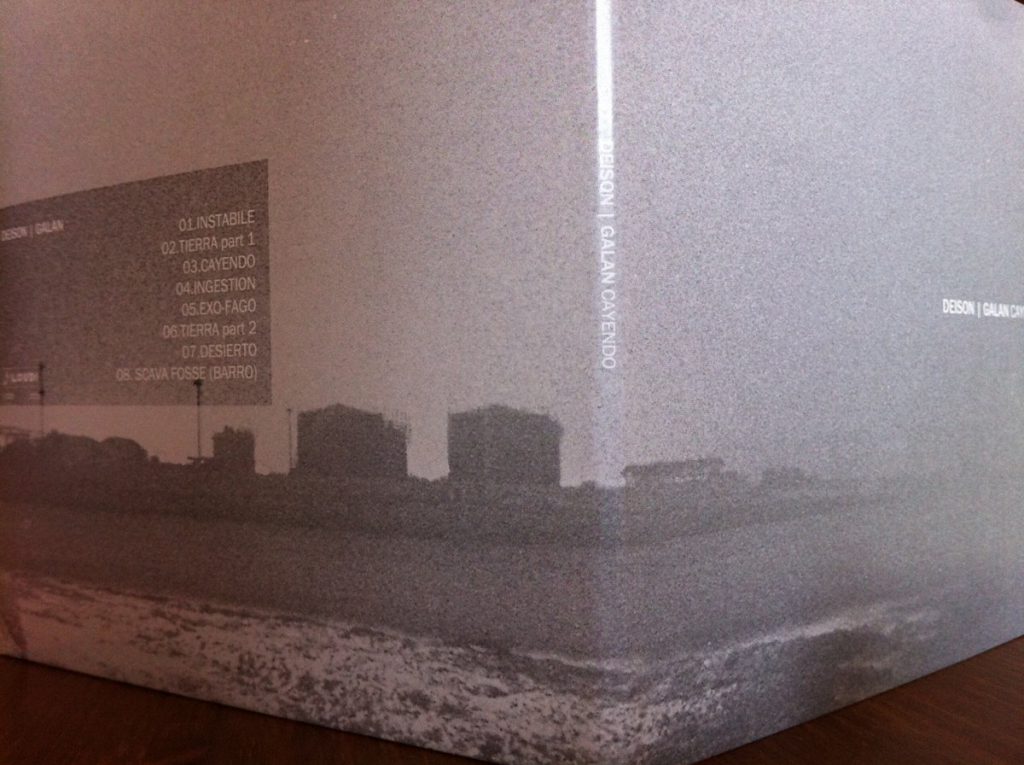DEISON/GALAN
(CD-R, Loud!, 2013)


- Instabile
- Tierra part 1
- Cayendo
- Ingestion
- Exo-fago
- Tierra part 2
- Desierto
- Scava fosse (barro)
“One meeting, one recording: 8 tracks. A cello mixed with dirty electronics”
In summer 2012 Deison meets in Spain Sara Galan, a cello artist based in Valencia.
In this meeting they decided to record some stuff together: some cello ambient drones
have been mixed with filed recordings, tapes and electronic sounds.
This improvised material was first inspired by the sentence repeated in loop for days: “Earth swallow me” (”Tierra tragame).
And then the concept leads to internal sounds, sound from stomach, sounds from the throat. Visceral sounds also connected with earth, sand, mud and desert.
Audio material has been manipulated and assembled in winter for a release on Loud! label, Deison’s personal record label re-activated after a long silence.
Francesca Mele provided the perfect visual imagery for the cover artwork with her b&w photography and Gianluca Becuzzi (Limbo,Noise Trade Company) mastered the album with his perfect touch.
CAYENDO SU THE NEW NOISE
Nuova collaborazione per Deison (il suo modo per essere sempre vitale, si direbbe), questa volta con la violoncellista spagnola Sara Galán, tutto realizzato durante un’unica seduta (improvvisativa?) e poi rielaborato in un secondo momento. Vien da pensare – più o meno lecitamente – a Hildur Guðnadóttir o allo svizzero Zeno Gabaglio, ma anche a Richard Skelton. La mano di Deison, al di là del paio di nomi buttati sul tavolo per provare a delimitare il territorio musicale, avvicina tutto al drone e lo lascia scabro e distante dalla melodia. L’idea di partenza (cayendo, cadendo, sprofondando…), del resto, mal si legherebbe alle declinazioni più scontatamente emotive del violoncello, anche se da un altro punto di vista non si assiste nemmeno a un continuo atto di violenza su di esso (restando nel 2013 basta sentire che succede al contrabbasso di The Ominous degli Jacob, in uscita per Utech). Di suo, del resto, il friulano sa benissimo scendere in maniera convincente sulle basse frequenze: qui basta sentire “Desierto”. L’interazione con la controparte “classica”, invece, gli permette di essere quasi “cinematografico” (nel corso di “Instabile” e della prima parte di “Tierra”) oppure dissonante nella title-track e in “Ingestion”, tutte salutari declinazioni del suono-Deison di partenza. Se ci si abitua alla generale “severità” di Cayendo e al suo non cercare mai facili appigli, allora è proprio un bel viaggio.
P.S.: come abbiamo già scritto, ormai parecchi anni fa Deison suonava assieme a uno che travalica di molto i confini di questa webzine e che sembra amare parecchio gli strumenti ad arco, specie da quando si occupa di colonne sonore… saremmo curiosi di sapere che ne pensa.
CAYENDO ON A CLOSER LISTEN
Italy’s Deison has been recording for decades, and is still experimenting with new ideas. He’s never settled into a single mode of recording or focused on a single genre. This creative restlessness has worked to his advantage. Cayendo doesn’t sound like any of Deison’s last three albums (all reviewed here) except in parts. The string segments of “Drone 11” (from Dead Man and a Skeleton Stag) form the closest connection, but the timbre is completely different. While that piece bordered on the industrial, the new material lands squarely in the realm of modern composition.
The difference this time around is made by Valencia cellist Sara Galan, who contributes evocative passages that are often looped but occasionally allowed to play through. The looping is less noticeable than one might think; because Deison alters the original sounds, repetition doesn’t always sound like repetition. The press release even contains an evocative typo: filed recordings rather than field recordings. And why not? Deison files Galan’s sounds down to a clean buff. By adding electronics, tapes, muffled voice and masked digestive noises, he creates something that is more than the sum of its parts: a deep composition in which every cello passage, even if initially improvised, sounds wholly intentional.
The album was inspired by the phrase, “earth swallow me”, and by thoughts of “earth, sand, mud and desert”. It’s easy to make the connection; Galan’s cello lurks along the base of a shallow pool, seeking to rise like the first amphibian. It’s a slow, deliberate rise that leads to a gasping of breath, but the effect is ultimately triumphant. Her cello work favors the rising tension of the long draw, most apparent on the dramatic, percussive opener, “Instabile”. The disembodied skitterings that litter the landscape may be the cries of other creatures: don’t go, don’t go. In “Ingestion”, Deison’s additions are both brighter (high pitched, bell-like tones) and darker (stomach rumblings?).
The best is saved for last, as the album’s longest and shortest tracks close the set. “Desierto” is as moody and forlorn as a parched man crawling toward an oasis. Deep reverberations form a sonic wall, as if in imitation of a rising sandstorm. Beeps and siftings serve as grit: sand in the eyes and doubt in the brain. When Galan’s cello emerges early in the third minute, it presents the album’s clearest tones. One can hear an invisible orchestra cueing up behind her. The brief “Scava fosse (barrio)” completes the journey, recessing into a crackled loop; perhaps the oasis was merely a mirage.